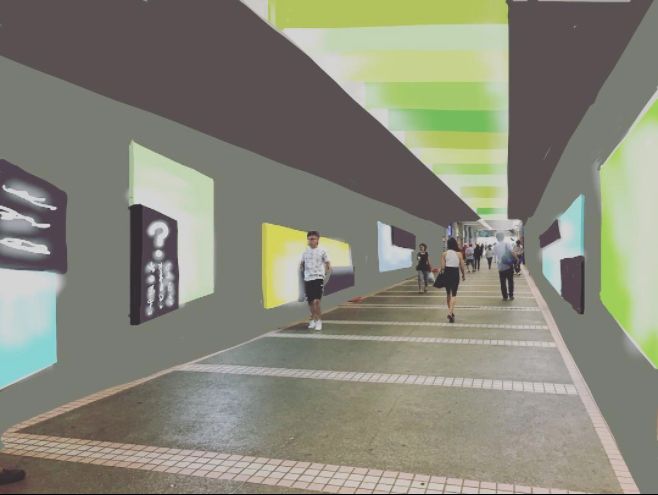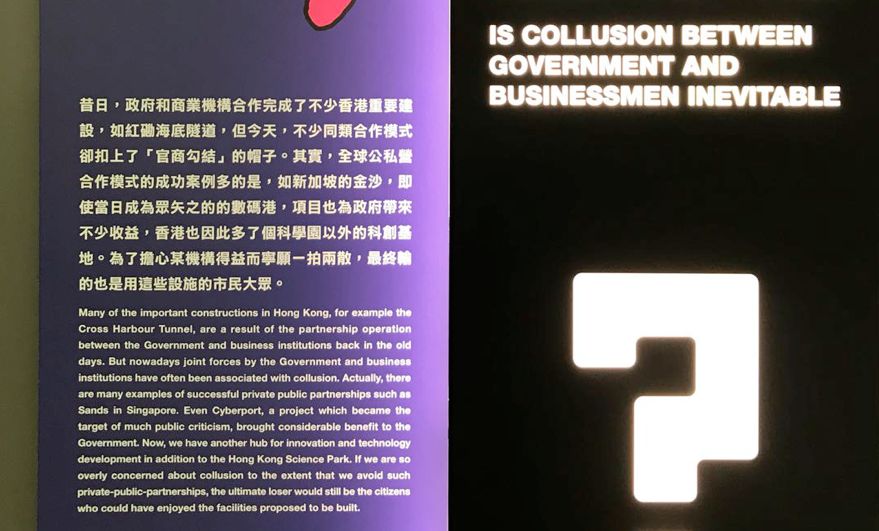Just last month, the Urban Renewal Authority started with its HK$740 million “rejuvenation” of the Central Market, after the remaining shops along the Central Escalator Link Alley were shut down and their tenants evicted.
A couple of weeks on, the corridor has been turned into an exhibition gallery as part of the Bi-City Biennale of Urbanism/Architecture (HK), which the Hong Kong Institute of Architects organizes together with Shenzhen. The Biennale is scheduled to last until mid-February. At the entrance, large panels illustrate what the Biennale is about, and where to see its exhibitions, from Hong Kong to Shenzhen.

Here is how it presents itself on its website: “The 2017 Bi-City Biennale of Urbanism\Architecture (Hong Kong) will hold exhibitions at 9 highly accessible vacant or shared urban locations and cultural hubs in Hong Kong and Shenzhen in which the 8 local venues are connected by MTR.”
“Themed ‘City Smarts: Density 2.0′, it shows the smart design of Hong Kong architecture and provides a public interactive platform for raising wider awareness and a greater general understanding about the sustainability of Hong Kong architecture and city planning.”

Awkward English aside, so far so boiler-plate.
The Central Market corridor has been draped with a dark synthetic canvas along the two walls, and on the ceiling are green and yellow banners that liven up the visual impact.
The exhibition, called “City Trivia (Cool facts of Hong Kong)” consists of a series of bright panels purporting to impart little known small facts to the unsuspecting passer-by.
The chief curator of the show is Chan Lai Kiu, an architect recently involved with the Hysan shopping mall and Lee Gardens, a few private-public sector projects, and a shop at PMQ.

By all accounts, City Trivia is trivial indeed. However, what is striking about it is how much even something so marginal today has to have a political agenda: pro-government, anti-British, and very preachy.
It pretends to be a series of “Did you know?!” questions about our city, which range from “Why is air conditioning so cold in Hong Kong?” to “Do you want the property price to be higher or lower?”
The answer to the first question is “perhaps because the British are accustomed to the chilly weather back home, the industry standard for air-conditioning is 22C.” And what about those property prices? If you think “lower” is desirable, you are misguided: “actually high property price is an indicator of a successful city.”

Another “trivia?” Here: “Is budget over-run on construction projects an unforgivable crime?” The answer is no: even if over-spending has been “heavily criticised by the society,” all in the field know that a lot of things can change through time – from inflation onwards. But projects with budgets that would take this into account “would not have been approved in the first place.”
And then: “Is collusion between government and business inevitable?” The answer to this trivial question is remarkable: partnership operations were the norm before, but nowadays they are “often associated with collusion.”

But “there are many examples of successful private-public partnerships such as Sands in Singapore. Even Cyberport, a project which became a target of much public criticism, brought considerable benefit to the Government.” Being too scared of collusion, it states, means fewer things would be built.
And we may think that Hong Kong is a young and energetic city, but compare it to 30-year old Shenzhen and in fact Hong Kong “often hesitates to act,” which deters it from “making good progress.”
The sponsors for the Bi-City Biennale are Create Hong Kong – a government office to promote creativity in design and architecture – Sun Hung Kai Property, Hong Kong Land, Nan Fung Group (also a real estate developer) and Wing Sum Construction and Engineering Corp.

So none of this is trivial for Hong Kong: a public building that the community had to mobilize to defend from the wrecking ball, now being rejuvenated in a very opaque way by the Urban Renewal Authority; a government-sponsored office that puts bureaucrats in charge of the city’s creativity while artists struggle to find working spaces and supporting institutions; and a flurry of real estate developers, once more treated as Hong Kong’s benefactors and not one of its scourges.
Meanwhile, on the same day as the exhibition was inaugurated and just a few minutes away from the Central Market corridor, the pro-establishment camp was intensifying its efforts to make sure that one of the last avenues left for people to have elected representatives able to talk to the government is rendered toothless. From farcical exhibitions to using anti-democratic tactics to block the opposition from having any impact, Hong Kong feels like a city under ideological siege.
